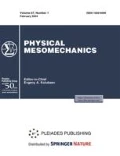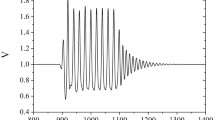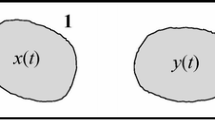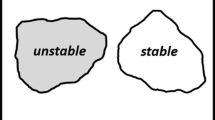Abstract
The paper investigates a model simulating crustal fault dynamics and strain wave generation in a fault block geological medium, the parameters determining sliding regimes in faults, and the physics of transitions between different deformation regimes. The model comprises the most important mechanisms responsible for the interaction of fault walls: friction, geometric irregularities (roughness and asperities on the fault surface), and external load, which govern sliding along the fault. The results of field and laboratory studies of deformation migration on the macro/mesoscale are consistent with the concept of localized deformation propagation in the form of solitary waves (kinks, solitons) and autowaves. The conditions are defined which make possible the transition from the model simulating solitary waves in a conservative medium with low “friction” (soliton-like behavior of the system) toward the model of solitary waves in an active medium with diffusion (autowave-like behavior of the system). Two possible deformation regimes of the fault block structure in the high-friction limit are considered. The fault wall displacement is stopped due to this friction, but the adjacent blocks move relative to each other in the core of the fault. It is shown that in the high-friction limit a perturbed sine-Gordon equation applied for fault dynamics modeling is reduced to a reaction-diffusion equation, whereas the system goes from the soliton regime to the autowave regime. In the case of high friction and a lack of energy supply to the fault from an external source, the transfer of localized deformation is changed by a diffusive dissipation of stress.


Similar content being viewed by others
REFERENCES
Lyakhovsky, V., Ben-Zion, Y., and Agnon, A., Distributed Damage, Faulting, and Friction, J. Geophys. Res. B, 1997, vol. 102, no. 12, pp. 27635–27649.
Kocharyan, G.G., Geomechanics of Faults, Moscow: GEOS, 2016.
Kocharyan, G.G. and Novikov, V.A., Experimental Study of Different Modes of Block Sliding along Interface: Part 1. Laboratory Experiments, Phys. Mesomech., 2016, vol. 19, no. 2, pp. 189–199.
Kocharyan, G.G., Ostapchuk, A.A., Pavlov, D.V., Ruzhich, V.V., Batukhtin, I.V., Vinogradov, E.A., Kamai, A.M., and Markov, V.K., Experimental Study of Different Modes of Block Sliding along Interface. Part 2. Field Experiments and Phenomenological Model of the Phenomenon, Phys. Mesomech., 2017, vol. 20, no. 2, pp. 193–202.
Budkov, A.M. and Kocharyan, G.G., Experimental Study of Different Modes of Block Sliding along Interface. Part 3. Numerical Modeling, Phys. Mesomech., 2017, vol. 20, no. 2, pp. 203–208.
Kocharyan, G.G., Novikov, V.A., Ostapchuk, A.A., and Pavlov, D.V., A Study of Different Fault Slip Modes Governed by the Gouge Material Composition in Laboratory Experiments, Geophys. J. Int., 2017, vol. 208, no. 1, pp. 521–528.
Makarov, P.V. and Peryshkin, A.Yu., Modeling of “Slow Movements” or Inelastic Deformation Autowaves in Ductile and Brittle Materials and Media, Phys. Mesomech., 2017, vol. 20, no. 2, pp. 209–221.
Makarov, P.V., Khon, Yu.A., and Peryshkin, A.Yu., Slow Deformation Fronts: Model and Features of Distribution, Geodyn. Tectonophys., 2018, vol. 9, no. 3, pp. 755–769.
Ben-Zion, Y. and Rice, J.R., Slip Patterns and Earthquake Populations along Different Classes of Faults in Elastic Solids, J. Geophys. Res. B, 1995, vol. 100, no. 7, pp. 12959–12983.
Sherman, S.I., Deformation Waves as a Trigger Mechanism of Seismic Activity in Seismic Zones of the Continental Lithosphere, Geodyn. Tectonophys., 2013, vol. 4, no. 2, pp. 83–117.
Bykov, V.G., Stick-Slip and Strain Waves in the Physics of Earthquake Rupture: Experiments and Models, Acta Geophys., 2008, vol. 56, no. 2, pp. 270–285.
Rubinstein, S.M., Cohen, G., and Fineberg, J., Detachment Fronts and the Onset of Dynamic Friction, Nature, 2004, vol. 430, pp. 1005–1009.
Nielsen, S., Taddeucci, J., and Vinciguerra, S., Experimental Observation of Stick-Slip Instability Fronts, Geophys. J. Int., 2010, vol. 180, pp. 697–702.
Sharon, E., Cohen, G., and Fineberg, J., Propagating Solitary Waves along a Rapidly Moving Crack Front, Nature, 2001, vol. 410, pp. 68–71.
Shibazaki, B. and Matsu’ura, M., Transition Process Nucleation to High-Speed Rupture Propagation: Scaling from Stick-Slip Experiments to Natural Earthquakes, Geophys. J. Int., 1998, vol. 132, no. 1, pp. 14–30.
Bykov, V.G., Model of Unsteady-State Slip Motion on a Fault in a Rock Sample, Izv. Phys. Sol. Earth, 2001, vol. 37, no. 6, pp. 484–488.
Ohnaka, M., The Physics of Rock Failure and Earthquakes, New York: Cambridge University Press, 2013.
Nikolaevsky, V.N., Geomechanics and Fluid Dynamics, Moscow: Nedra, 1996.
Firstov, P.P., Makarov, E.O., and Glukhova, I.P., Peculiarities of Subsoil Gas Dynamics before the M = 7.2 Zhupanovo Earthquake of January 30, 2016, Kamchatka, Dokl. Earth Sci., 2017, vol. 472, no. 2, pp. 196–199.
Kuzmin, Yu.O., Deformation Autowaves in Fault Zones, Izv. Phys. Sol. Earth, 2012, vol. 48, no. 1, pp. 1–16.
Spirtus, V.B., Features of the Dynamics of Seismic Activity in Models of the FitzHugh–Nagumo type, Geofiz. Zh., 2011, vol. 33, no. 1, pp. 57–63.
Zuev, L.B., Barannikova, S.A., Zhigalkin, V.M., and Nadezhkin, M.V., Laboratory Observation of Slow Movements in Rocks, J. Appl. Mech. Tech. Phys., 2012, vol. 53, no. 3, pp. 467–470.
Garagash, I.A., Microdeformations of a Prestressed Discrete Geophysical Medium, Dokl. Earth Sci., 1996, vol. 347, no. 2, pp. 324–327.
Vikulin, A.V. and Ivanchin, A.G., The Rotational Model of the Seismic Process, Tikhookean. Geolog., 1998, vol. 17, no. 6, pp. 95–103.
Gershenzon, N.I., Bykov, V.G., and Bambakidis, G., Strain Waves, Earthquakes, Slow Earthquakes, and Afterslip in the Framework of the Frenkel–Kontorova Model, Phys. Rev. E, 2009, vol. 79, no. 5, p. 056601.
Bykov, V.G., Sine-Gordon Equation and Its Application to Tectonic Stress Transfer, J. Seismology, 2014, vol. 18, no. 3, pp. 497–510.
Cartwright, J.H.E., Hernandez-Garcia, E., and Piro, O., Burridge–Knopoff Models as Elastic Excitable Media, Phys. Rev. Lett., 1997, vol. 79, no. 3, pp. 527–530.
Morales, J.E.M., James, G., and Tonnelier, A., Solitary Waves in the Excitable Burridge–Knopoff Model: Technical Report RR-8996, INRIA Grenoble–Rhone-Alpes, 2016.
Bykov, V.G., Waves of Activation in Crustal Faults, Tikhookean. Geolog., 2000, vol. 19, no. 1, pp. 104–108.
Kerner, B.S. and Osipov, V.V., Autosolitons, Sov. Phys. Usp., 1989, vol. 32, vol. 2, pp. 101–138.
Davydov, V.A., Zykov, V.S., and Mikhailov, A.S., Kinematics of Autowave Structures in Excitable Media, Sov. Phys. Usp., 1991, vol. 34, vol. 8, pp. 665–684.
Landa, P.S., Nonlinear Oscillations and Waves in Dynamic Systems, Dordrecht: Klüwer Academic Publ., 1996.
Ivanitskii, G.R., Biophysics at the Turn of the Century: Autowaves, Biofizika, 1999, vol. 44, no. 5, pp. 773–795.
Kivshar, Yu.S. and Malomed, B.A., Dynamics of Solitons in Nearly Integrable Systems, Rev. Mod. Phys., 1989, vol. 61, no. 4, pp. 763–915.
Mishchenko, E.F., Sadovnichii, V.A., Kolesov, A.Yu., and Rozov, N.Kh., Autowave Processes in Nonlinear Media with Diffusion, Moscow: Fizmatlit, 2005.
Kerner, B.S. and Osipov, V.V., Autosolitons: Localized Highly Nonequilibrium Regions in Homogeneous Dissipative Systems, Moscow: Nauka, 1991, pp. 773–795.
McLaughlin, D.W. and Scott, A.C., A Multisoliton Perturbation Theory, Solitons in Action, Lonngren, K. and Scott, A., Eds., New York: Academic Press, pp. 201–256.
Elsasser, W.M., Convection and Stress Propagation in the Upper Mantle, in The Application of Modern Physics to the Earth and Planetary Interiors, Runcorn, S.K., Ed., New York: Wiley Interscience, 1969, pp. 223–246.
Bott, M.H.P. and Dean, D.S., Stress Diffusion from Plate Boundaries, Nature, 1973, vol. 243, pp. 339–341.
Anderson, D.L., Accelerated Plate Tectonics, Science, 1975, vol. 187, pp. 1077–1079.
Baranov, B.V. and Lobkovskii, L.I., Small-Focus Seismicity behind the Kuril Island Arc and Its Relation to the Zavaritsky–Benioff Zone, Dokl. Akad. Nauk SSSR, 1980, vol. 255, no. 1, pp. 104–108.
Ida, Y., Slow-Moving Deformation Pulses along Tectonic Faults, Phys. Earth Planet. Int., 1974, vol. 9, pp. 328–337.
Bella, F., Biagi, P.F., Caputo, M., Della Monica, G., Ermini, A., Manjgaladze, P., Sgrigna, V., and Zilpimian, D., Very Slow-Moving Crustal Strain Disturbances, Tectonophysics, 1990, vol. 179, no. 1–2, pp. 131–139.
Rice, J., The Mechanics of Earthquake Rupture, in Physics of Earth’s Interior, Proc. Int. School of Physics E. Fermi, 1979, Dziewonski, A.M. and Boschi, E. (Eds.), Amsterdam: Italian Physical Society, North Holland Publ. Co., 1980, pp. 555–649.
Johnson, P.A. and McEvilly, T.V., Parkfield Seismicity: Fluid-Driven?, J. Geophys. Res. B, 1995, vol. 100, no. 7, pp. 12937–12950.
Scholz, C.H., The Mechanics of Earthquake and Faulting, Cambridge: Cambridge University Press, 2002.
Bykov, V.G., Prediction and Observation of Strain Waves in the Earth, Geodyn. Tectonophys., 2018, vol. 9, no. 3, pp. 721–754.
Sobolev, G.A., Fundamentals of Earthquake Prediction, Moscow: Nauka, 1993.
Johnston, M.J.S. and Linde, A.T., Implications of Crustal Strain during Conventional, Slow, and Silent Earthquakes, in International Handbook of Earthquake and Engineering Seismology, vol. 81, part A, Lee, W.H.K., Kanamori, H., Jennings, P.C., and Kisslinger, C., Eds., Academic Press, 2002, pp. 589–605.
Putelat, T., Dawes, J.H.P., and Champneys, A.R., A Phase-Plane Analysis of Localized Frictional Waves, Proc. R. Soc. A, 2017, vol. 473, p. 20160606.
Guberman, Sh.A., On Some Regularities of the Occurrence of Earthquakes, Dokl. Akad. Nauk SSSR, 1975, vol. 224, no. 3, pp. 573–576.
Mikhailov, D.N. and Nikolaevskii, V.N., Tectonic Waves of the Rotational Type Generating Seismic Signals, Izv. Phys. Sol. Earth, 2000, vol. 36, no. 11, pp. 895–902.
Erickson, B.A., Birnir, B., and Lavallee, D., Periodicity, Chaos and Localization in a Burridge–Knopoff Model of an Earthquake with Rate-and-State Friction, Geophys. J. Int., 2011, vol. 187, pp. 178–198.
Senatorski, P., Interactive Dynamics of Faults, Tectonophysics, 1997, vol. 277, no. 1–2, pp. 199–207.
Liu, M., Stein, S., and Wang, H., 2000 Years of Migrating Earthquakes in North China: How Earthquakes in Midcontinents Differ from Those at Plate Boundaries, Lithosphere, 2011, vol. 3, pp. 128–132.
Herz, A.V.M. and Hopfield, J.J., Earthquake Cycles and Neural Reverberations: Collective Oscillations in Systems with Pulse-Coupled Threshold Elements, Phys. Rev. Lett., 1995, vol. 75, no. 6, pp. 1222–1225.
Scholz, C.H., Large Earthquake Triggering, Clustering, and the Synchronization of Faults, Bull. Seismol. Soc. Am., 2010, vol. 100, no. 3, pp. 901–909.
Novopashina, A.V. and Sankov, V.A., Migrations of Released Seismic Energy in Various Geodynamic Conditions, Geodyn. Tectonophys., 2018, vol. 9, no. 1, pp. 139–163.
Bornyakov, S.A., Tarasova, A.A., and Panteleev, I.A., Dynamics of Intrafault Deformation Waves: Results of Physical Simulation, Dokl. Earth Sci., 2016, vol. 471, no. 2, pp. 1316–1318.
Author information
Authors and Affiliations
Corresponding author
Additional information
Russian Text © The Author(s), 2019, published in Fizicheskaya Mezomekhanika, 2019, Vol. 22, No. 4, pp. 39–46.
Rights and permissions
About this article
Cite this article
Bykov, V.G. Development of Sliding Regimes in Faults and Slow Strain Waves. Phys Mesomech 23, 271–278 (2020). https://doi.org/10.1134/S1029959920030121
Received:
Revised:
Accepted:
Published:
Issue Date:
DOI: https://doi.org/10.1134/S1029959920030121




